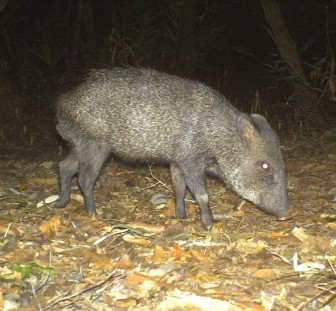Rain forests are rich in biodiversity and are home to many different plants and animals as well as indigenous communities. Humans, even those who don’t live in the rain forest, rely on it for resources such as building materials (wood and lianas), medicine and fruits. Rain forests also provide essential environmental services for life on earth; they create soil as well as prevent soil erosion, produce oxygen though photosynthesis, maintain clean water systems, and are a key defence against climate change.
The Iwokrama Rain Forest is 371,000 hectares, located in the heart of Guyana. Our mission is to develop strategies for conservation and sustainable development for local people in Guyana and the world at large. We are involved in timber, tourism and training. Come and visit us in the rain forest or at http://www.iwokrama.org.
Peccaries are large, chunky animals with slender legs, large heads, thick necks and a short, almost invisible tail. They have large sharp canines and the upper ones point downwards. Their closest relations are pigs but they are in a separate family.
Unlike pigs, peccaries have small litters, usually one or two, which follow their mother shortly after birth. In Guyana, there are 2 species of peccary or ‘wild hog,‘ the white lipped peccary and the collared peccary.

The collared peccary (Tayassu tajacu) or Prakka in Makushi, has grizzled grey black and bristly fur, with a crest of longer hair from head to rump and a distinct collar of pale yellow hairs from the top of the shoulder to the lower cheek.
Peccaries are diurnal and inhabit rainforests, travelling in loose groups of 1-20 (White Lipped Peccaries form large herds of 50–300) often moving in single file looking for forage of fruits, palm nuts, browse, invertebrates and small vertebrates. They are wary and surprisingly quiet, making a bark or clacking their teeth in alarm and while in flight. They are excellent swimmers and will cross rivers and creeks in search of food.
Peccaries frequently mark trails by scraping the ground in front of a pole, defecating on the ground and then rubbing their scent gland on the pole. This musky scent is distinctive of the ‘wild hog‘ and the scent will linger for hours after they mark.
Collared Peccary are hunted for their meat by game hunters and are an important food resource for indigenous people.
They are hunted opportunistically by indigenous people when they uproot and destroy cassava farms or are found swimming in the river.
A successful peccary hunt is a special event and the meat is shared amongst the hunters and extended family members. The teeth are used for necklaces, earrings and long ago, the skins were used to make the ‘lap‘ or traditional wear of the Makushi.





